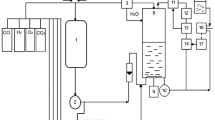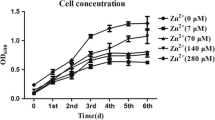Abstract
Cell growth and accumulation of polyhydroxybutyric acid, P(3HB), from CO2 in autotrophic condition of a newly isolated hydrogen-oxidizing bacterium, the strain O-1, was investigated. The bacterium, which was deposited in the Japan Collection of Microorganisms as JCM17105, autotrophically grows by assimilating H2, O2, and CO2 as substrate. 16S rRNA gene sequence of the bacterium was the closest to Ideonella dechloratans (99%). Specific growth rate of the strain O-1 was faster than a hydrogen-oxidizing bacterium, Ralstonia eutropha, which is well-known P(3HB)-producing microorganism. The strain O-1 is tolerant to high O2 concentration and it can grow above 30% (v/v) O2, while the growth of R. eutropha and Alcaligenes latus was seriously inhibited. In culture medium containing 1 g/L (NH4)2SO4, cell concentration of the strain O-1 and P(3HB) increased to 6.75 and 5.26 g/L, respectively. The content of P(3HB) in the cells was 77.9% (w/w). The strain O-1 was very tolerant to carbon monoxide (CO) and it grew even at 70% (v/v) CO, while the growth of R. eutropha and A. latus were seriously inhibited at 5% (v/v) CO. From these results, it is expected that the strain O-1 will be useful in the manufacture of P(3HB) because the industrial exhaust gas containing CO2, H2, and CO can be directly used as the substrate in the fermentation process.






Similar content being viewed by others
References
Ahn WS, Park SJ, Lee SY (2000) Production of poly(3-hydroxybutyrate) by fed-batch culture of recombinant Escherichia coli with a highly concentrated whey solution. Appl Environ Microbiol 66:3624–3627
Ammann ECB, Reed LL, Durichek JE Jr (1968) Gas consumption and growth rate of Hydrogenomonas eutropha in continuous culture. Appl Microbiol 16:822–826
Anderson A, Dawes EA (1990) Occurrence, metabolism, metabolic role, and industrial uses of bacterial polyhydroxyalkanoates. Microbiol Rev 54:450–472
Bongers L (1970) Energy generation and utilization in hydrogen bacteria. J Bacteriol 104:145–151
Byrom D (1994) Polyhydroxyalkanoates. In: Mobley DP (ed) Plastics from microbes: microbial synthesis of polymers and polymer precursors. Hanser, Munich, pp 5–33
Choi J, Lee SY (1999a) Factors affecting the economics of polyhydroxyalkanoate production by bacterial fermentation. Appl Microbiol Biotechnol 51:13–21
Choi J, Lee SY (1999b) High-level production of poly(3-hydroxybutyrate-co-3-hydroxyvalerate) by fed-batch culture of recombinant Escherichia coli. Appl Environ Microbiol 65:4346–4348
Elbeltagy A, Nishioka K, Sato T, Suzuki H, Ye B, Hamada T, Isawa T, Mitsui H, Minamisawa K (2001) Endophytic colonization and in planta nitrogen fixation by a Herbaspirillum sp. isolated from wild rice species. Appl Environ Microbiol 67:5285–5293
Goto E, Suzuki K, Kodama T (1977) Improvement of initial and exponential growth of hydrogen bacteria, strain 9-5. Agr Biol Chem 41:521–525
Ishizaki A, Tanaka K (1990) Batch culture of Alcaligenes eutrophus ATCC 17697T using recycled gas closed circuit culture system. J Ferment Bioeng 69:170–174
Ishizaki A, Tanaka K (1991) Production of poly-β-hydroxybutyric acid from carbon dioxide by Alcaligenes eutrophus ATCC 17697T. J Ferment Bioeng 70:254–257
Kim BS, Lee SC, Lee SY, Chang HN, Chang YK, Woo SI (1994) Production of poly(3-hydroxybutyric-co-3-hydroxyvaleric acid) by fed-batch culture of Alcaligenes eutrophus with substrate control using on-line glucose analyzer. Enzyme Microbiol Technol 16:556–561
Kodama T, Igarashi Y, Minoda Y (1975) Isolation and culture conditions of a bacterium grown on hydrogen and carbon dioxide. Agr Biol Chem 39:77–82
Lee IY, Kim MK, Kim GK, Chang HN, Park YH (1995) Production of poly(β-hydroxybutyrate-co-β-hydroxyvalerate) from glucose and valerate in Alcaligenes eutrophus. Biotechnol Lett 17:571–574
Lee SY, Choi J, Wong HH (1999) Recent advances in polyhydroxyalkanoate production by bacterial fermentation. Int J Biol Macromol 25:31–36
Malmqvist A, Welander T, Moore E, Ternström A, Molin G, Stenström IM (1994) Ideonella dechloratans gen. nov., sp. nov., a new bacterium capable of growing anaerobically with chlorate as an electron acceptor. Syst Appl Microbiol 17:58–64
Miura Y, Okazaki M, Ohi K, Nishimura T, Komemushi S (1982) Optimization of biomass productivity and substrate utility of a hydrogen bacterium, Alcaligenes hydrogenophilus. Biotechnol Bioeng 24:1173–1182
Morinaga Y, Yamanaka S, Ishizaki A, Hirose Y (1978) Growth characteristics and cell composition of Alcaligenes eutrophus in chemostat culture. Agr Biol Chem 42:439–444
Noar JD, Buckley DH (2009) Ideonella azoifingens sp. nov., an aerobic diazotroph of the Betaproteobacteria isolated from grass rhizosphere soil, and emended description of the genus Ideonella. Int J Syst Evol Microbiol 59:1941–1946
Ohi K, Matsumoto H, Yamada K (1979) Cultivation and characterization of a hydrogen bacterium, Alcaligenes hydrogenophilus sp. nov. J Ferment Technol 57:195–202
Repaske R (1961) Nutritional requirements for Hydrogenomonas eutropha. J Bacteriol 83:418–422
Repaske R (1966) Characteristics of hydrogen bacteria. Biotechnol Bioeng 8:217–235
Repaske R, Mayer R (1976) Dense autotrophic cultures of Alcaligenes eutrophus. Appl Environ Microbiol 32:592–597
Repaske R, Repaske AC (1976) Quantitative requirement for exponential growth of Alcaligenes eutrophus. Appl Environ Microbiol 32:585–591
Ryu HW, Hann SK, Chang YK, Chang HN (1997) Production of poly(3-hydroxyvutyrate) by high cell density fed-batch culture of Alcaligenes eutrophus with phosphate limitation. Biotechnol Bioeng 55:28–32
Savelieva ND (1979) Microbiology. On response of hydrogen bacteria to carbon monoxide. Mikrobiologiya 48:360–362 (in Russian)
Savelieva ND, Zhilina TN (1968) On systematics of hydrogen bacteria. Mikrobiologiya 37:84–91 (in Russian)
Schlegel HG (1989) Aerobic hydrogen-oxidizing (Knallgas) bacteria. In: Schlegel HG, Bowien B (eds) Autotrophic bacteria. Science Tech, Madison, pp 305–329
Schlegel HG, Lafferty RM (1971) Novel energy and carbon sources. The production of biomass from hydrogen and carbon dioxide. Adv Biochem Eng 143:143–168
Sonnleitner B, Heinzle E, Braunegg G, Lafferty RM (1979) Formal kinetics of poly-β-hydroxybutyric acid (PHB) production in Alcaligenes eutrophus H16 and Mycoplana rubra R14 with respect to the dissolved oxygen tension in ammonium-limited batch cultures. Eur J Appl Microbiol Biotechnol 7:1–10
Stasishina GN, Volova TG (1996) The strain of bacteria Alcaligenes eutrophus. RF Patent No. 2053292. Bull. No. 3
Steinbüchel A, Hein S (2001) Biochemical and molecular basis of microbial synthesis of polyhydroxyalkanoates in microorganisms. Adv Biochem Eng Biotechnol 71:81–123
Sugimoto T, Tsuge T, Tanaka K, Ishizaki A (1999) Control of acetic acid concentration by pH-stat continuous substrate feeding in heterotrophic culture phase of two-stage cultivation of Alcaligenes eutrophus for production of P(3HB) from CO2, H2 and O2 under non-explosive condition. Biotechnol Bioeng 62:625–631
Suzuki T, Yamane T, Shimizu S (1986) Mass production of poly-β-hydroxybutyric acid by fed-batch culture with controlled carbon/nitrogen feeding. Appl Microbiol Biotechnol 24:370–374
Taga N, Tanaka K, Ishizaki A (1997) Effects of rheological change by addition of carboxymethylcellulose in culture media of an air-lift fermentor on poly-d-3-hydroxybutyric acid productivity in autotrophic culture of hydrogen-oxidizing bacterium, Alcaligenes eutrophus. Biotechnol Bioeng 53:529–533
Takeshita T, Tanaka K, Ishizaki A, Stanbury PF (1993) Development of a dissolved hydrogen sensor and its application to evaluation of hydrogen mass transfer. J Ferment Bioeng 76:148–150
Tanaka K, Ishizaki A (1994) Production of poly-D-3-hydroxybutyric acid from carbon dioxide by a two-stage culture method employing Alcaligenes eutrophus ATCC 17697T. J Ferment Bioeng 77:425–427
Tanaka K, Ishizaki A, Kanamaru T, Kawano T (1995) Production of poly(D-3-hydroxybutyrate) from CO2, H2, and CO2 by high cell density autotrophic cultivation of Alcaligenes eutrophus. Biotechnol Bioeng 45:268–275
Volova TG, Kalacheva GS, Stasishina GN, Kasaeva GE (1980) Investigation of the growth of hydrogen bacteria under inhibition by carbon monoxide. Mikrobiologiya 49:465–471 (in Russian)
Volova TG, Guseinov OA, Kalacheva GM, Medvedeva SE, Puzyr AAP (1993) Effect of carbon monoxide on metabolism and ultrastructure of carboxydobacteria. World J Microbiol Biotechnol 9:160–163
Volova TG, Kalacheva GS, Altukhova OV (2002) Autotrophic synthesis of polyhydroxyalkanoates by the bacteria Ralstonia eutropha in the presence of carbon monoxide. Appl Microbiol Biotechnol 58:675–678
Wang F, Lee SY (1997a) Production of poly(3-hydroxybutyrate) by fed-batch culture of filamentation-suppressed recombinant Escherichia coli. Appl Environ Microbiol 63:4765–4769
Wang F, Lee SY (1997b) Poly(3-hydroxybutyrate) production of with high productivity and high polymer content by a fed-batch culture of Alcaligenes latus under nitrogen limitation. Appl Environ Microbiol 63:3703–3706
Yamane T, Fukunaga M, Lee YW (1996) Increase PHB production by high-cell-density fed-batch culture of Alcaligenes latus, a growth-associated PHB producer. Biotechnol Bioeng 50:197–202
Zinn M, Witholt B, Egli T (2001) Occurrence, synthesis and medical application of bacterial polyhydroxyalkanoate. Adv Drug Deliv Rev 53(1):5–21
Acknowledgement
A part of this study was supported by a scientific grant from JFE Steel Corporation, Japan.
Author information
Authors and Affiliations
Corresponding author
Rights and permissions
About this article
Cite this article
Tanaka, K., Miyawaki, K., Yamaguchi, A. et al. Cell growth and P(3HB) accumulation from CO2 of a carbon monoxide-tolerant hydrogen-oxidizing bacterium, Ideonella sp. O-1. Appl Microbiol Biotechnol 92, 1161–1169 (2011). https://doi.org/10.1007/s00253-011-3420-2
Received:
Revised:
Accepted:
Published:
Issue Date:
DOI: https://doi.org/10.1007/s00253-011-3420-2




